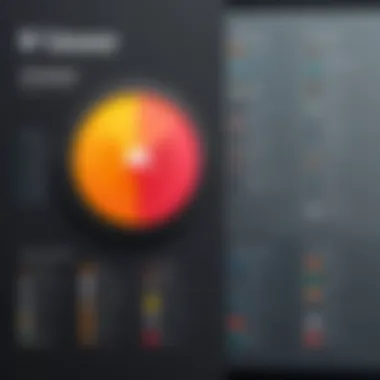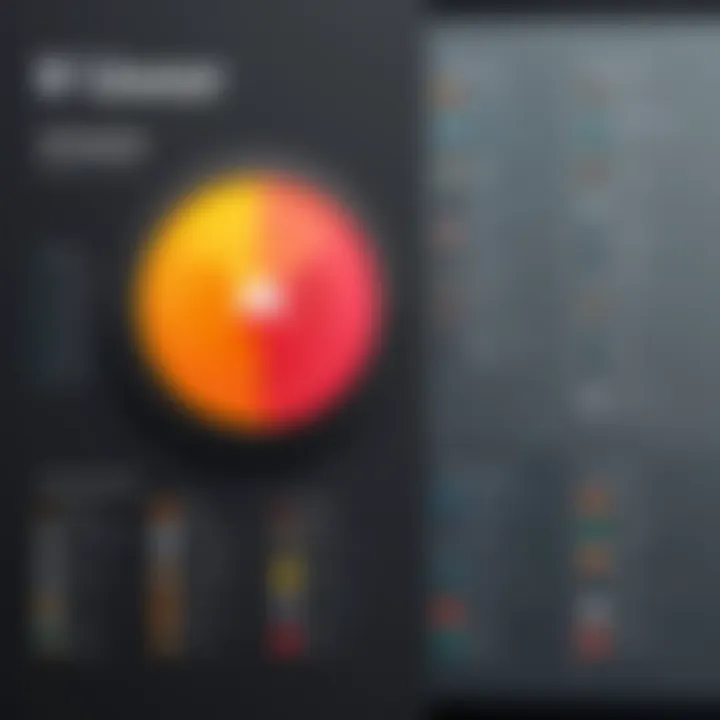Adobe Illustrator Student Discount: A Complete Overview


Intro
Adobe Illustrator stands as a titan in the graphic design world, a go-to choice for professionals and students alike. Its robust features and versatility make it essential, especially for those diving into the realm of visual creativity. However, for students, the price tag can be a hurdle. This is where Adobe's student discount comes into play, offering a lifeline for aspiring designers looking to harness the power of this software without breaking the bank.
With the landscape of graphic design ever-evolving, understanding how to efficiently access these discounts, alongside mastering the software itself, is critical for anyone wishing to sharpen their design skills. This guide aims to dissect the essential elements of Adobe Illustrator’s student discount, paving the way for students and educators to not only avail themselves of the savings but to also maximize the potential of the software itself.
Software Overview
Features and functionalities overview
Adobe Illustrator is packed to the brim with capabilities that cater to a wide range of artistic pursuits. Key features include:
- Vector graphics: Unlike raster images, vector art retains quality at any scale, making it ideal for logos and illustrations.
- Text handling: With advanced typography tools, users can manipulate text to fit their designs perfectly.
- Brushes and effects: A rich library of brushes and effects provides creatives the tools to add flair to their illustrations.
- Integration with other Adobe software: Seamless integration with Photoshop, InDesign, and more is crucial for comprehensive design workflows.
User interface and navigation
The interface of Illustrator is tailored for usability. New users may find the learning curve a bit steep at first, but the layout is pretty intuitive. Key tools are grouped logically, allowing users to navigate between features with relative ease. The workspace can also be customized, letting each user mold their environment for optimum efficiency.
Compatibility and integrations
Another plus for Illustrator is its compatibility. It runs on both Windows and macOS, which is a great boon for students who might not have a specific operating system preference. Additionally, it plays well with other Adobe applications, making cross-platform projects a breeze.
Pros and Cons
Strengths
- Industry standard: Illustrator is widely regarded in the professional world, meaning proficiency in it can significantly enhance a student's resume.
- Extensive resources: There’s a wealth of tutorials and community forums online, including platforms like Reddit, that support new learners.
- Flexible subscription model: With the student discount, the software becomes more accessible, alleviating some of the financial burden.
Weaknesses
- Steep learning curve: For absolute beginners, the initial experience might feel overwhelming due to the myriad of tools and settings available.
- Resource-intensive: Running Illustrator can be taxing on older computers, which might lead to slower performance for those using outdated hardware.
Comparison with similar software
While Adobe Illustrator is often held up as the gold standard, alternatives like CorelDRAW and Affinity Designer also present compelling features. CorelDRAW offers more intuitive tools for layout design, whereas Affinity Designer has a one-time payment model, which might appeal to budget-conscious students. Still, the depth of Illustrator's feature set often gives it an edge.
Pricing and Plans
Subscription options
Adobe offers various pricing plans; however, for students, the savings are substantial. The student discount typically provides almost a 60% cut on monthly subscriptions. The standard pricing can be a barrier, but when tailored for students, it transforms into an approachable option.
Free trial or demo availability
There’s usually a free trial available for those eager to dip their toes before fully committing. This trial version allows potential users to explore the software's functionality at no cost, thus making an informed choice easier.
Value for money
Considering both the feature set and student discount, many find that Adobe Illustrator delivers excellent value for money. Especially for those who invest time to learn, the benefits compound over time.
Expert Verdict
Final thoughts and recommendations
Overall, Adobe Illustrator stands out as an essential tool for aspiring graphic designers. With its extensive features and a student-centric pricing model, it’s hard to overlook the advantages it offers.
Target audience suitability
This software is ideal for students pursuing graphic design, digital art, marketing, or related fields. Educators, too, can benefit by incorporating it into their curriculum effectively.
Potential for future updates
As the design industry continually evolves, it’s reasonable to expect Adobe to keep updating Illustrator with more tools and features that cater to new trends, like augmented reality or advanced 3D modeling. Keeping an eye on these changes could further enrich the creative capabilities of students using this program.
Understanding Adobe Illustrator
Understanding Adobe Illustrator is crucial for anyone looking to explore graphic design, whether you’re a budding artist or a seasoned professional. This section sets the stage for delving into the nuances of the software and the invaluable discount opportunities available to students. Adobe Illustrator isn’t just a tool; it’s a powerful platform that has influenced the way we approach digital artwork and vector graphics. By comprehending its core functions and significance in the design world, one can leverage the student discount effectively.
Overview of Adobe Illustrator
Adobe Illustrator is a vector graphics editor developed by Adobe Inc. It allows users to create and manipulate graphics using points, lines, and shapes which are defined mathematically. This means artworks created in Illustrator remain high quality, no matter how much you resize or scale them, unlike raster-based programs which can pixelate. This characteristic makes Illustrator an essential tool for tasks ranging from logo design to complex illustrations and everything in between.
The interface of Illustrator, while rich in functionality, is tailored to be user-friendly. Users can navigate through multiple menus and panels to access various tools, including drawing, color grading, and typography. One noteworthy feature is the Artboard concept, which permits designers to work on multiple canvases within a single document. This flexibility provides a huge advantage for multitasking designers who juggle several projects at once.


Furthermore, the integration with other Adobe products like Photoshop and InDesign enhances its capabilities, making it a cornerstone in the Adobe Creative Cloud suite. This interconnectedness streamlines workflows and fosters an environment where creativity can thrive.
Importance in Graphic Design
In the realm of graphic design, Adobe Illustrator holds a pivotal position. Its emphasis on precision and scalability makes it a go-to choice for professionals who demand accuracy in their designs. Graphic design often hinges on visual communication, and Illustrator equips designers to convey messages that resonate.
The software excels in producing clean, crisp lines and can handle complex designs without compromising quality. It is particularly favored in branding, advertising, and publishing due to this characteristic. A well-designed logo or branding asset created in Illustrator can stand the test of time; it can be resized for a business card just as effectively as for a billboard.
Moreover, the ability to create illustrations that are both artistic and functional means artists can explore various styles, from minimalist icons to intricate illustrations. As the design industry continues to evolve, the significance of mastering Illustrator becomes even more pronounced. With a broad scope of features, any designer willing to invest their time in learning the software is arming themselves with an invaluable asset for their career.
The ability to manipulate vector graphics is not just a skill; it’s an art form that can change the way ideas are communicated.
To summarize, understanding Adobe Illustrator not only enriches one’s design toolkit but opens doors to numerous opportunities in various creative fields. With this knowledge, students can seize the available discounts to access professional-grade tools that might otherwise be beyond their financial reach.
Student Discount Eligibility
Determining eligibility for the student discount on Adobe Illustrator is a crucial step in ensuring that students can access powerful design tools without breaking the bank. The discount not only alleviates the financial burden many students face but also encourages the adoption of professional-grade software in academic settings. By understanding the criteria and requirements, students can make informed decisions and take full advantage of this significant financial incentive.
Who Qualifies for the Discount?
Qualifying for the Adobe Illustrator student discount hinges on a few key factors. Generally, this offer is extended to:
- Full-time and Part-time Students: If you are currently enrolled at an accredited institution, whether it be a high school, college, or university, you may be eligible.
- Educators: Those who teach at eligible institutions can also benefit, often using the software in their curriculum.
- Recent Graduates: Some programs may extend eligibility to graduates who have recently completed their studies, allowing a bit of leeway on the timing of application.
However, each institution might have its specific rules and guidelines. It’s always best to check locally to ensure that one's enrollment status aligns with the established criteria.
Acceptable Forms of Student Verification
When applying for the discount, proper verification is critical. The following forms of identification are commonly accepted:
- Student ID Cards: A clear photo of your student ID which displays your name, school name, and valid dates usually suffices.
- Enrollment Verification Letters: A letter from your school or institution that confirms your current enrollment can work as well.
- Class Schedules: A printout of your current course schedule with your name and school logo can often be used for verification.
"Having your documentation ready can speed up the application process and ensure you don’t hit any snags."
In some cases, Adobe may request additional information to confirm eligibility thoroughly; having these documents handy will undoubtedly make life easier. Adhering to the guidelines will streamline the process and smooth out the bumps along the way.
With the right qualifying status and verification in place, students can unlock significant savings, elevating their design skills in the process.
How to Apply for the Discount
Applying for the student discount on Adobe Illustrator is a significant step for students venturing into graphic design. Understanding the application process can not only save you a considerable amount of money but also open doors to enhancing your skills and portfolio. Many students may overlook this aspect, assuming the process is either too complicated or not worth their time. However, being equipped with the right information can set you on the path to using one of the most powerful design tools available.
A successful application leads to financial savings that can be reinvested into other learning resources or even personal projects. It’s worth noting that Adobe frequently updates its offers so, always keep an eye out for promotions that might further benefit students.
Step-by-Step Application Process
- Visit the Official Adobe Website: Navigate to the Adobe website and locate the section dedicated to student discounts. This is crucial because this is your starting point for all the necessary information.
- Create an Adobe Account: If you don’t have an Adobe account yet, you'll need to make one. It’s a straightforward process that requires an email address, so keep it handy.
- Select Your Preferred Plan: Adobe typically offers multiple subscription plans with varying features. Choose the one that best matches your needs as a student.
- Provide Student Verification: This step is critical. You’ll likely be asked to verify your student status. This might mean uploading verifiable documents, such as a student ID or enrollment verification letter.
- Make the Payment: After successful verification, proceed with payment. The student discount should automatically apply at this stage. Be sure to check the final pricing before completing this step.
- Download Adobe Illustrator: Once payment is confirmed, you can download Illustrator. Follow the installation instructions carefully to ensure a smooth start.
"Saving money as a student is always a boon; use these discounts wisely!"
Common Application Pitfalls
Despite the seemingly simple application process, many students encounter pitfalls. Some common issues include:
- Invalid Verification Documents: Make sure the documents you submit are clear and valid. Blurred images or outdated IDs can lead to rejection.
- Incorrect Email Address: Ensure you provide a valid email that you check regularly. Adobe will likely reach out to you during the verification process.
- Missing Deadline: Discounts may have specific application periods. Keep an eye on deadlines to avoid losing out.
- Choosing the Wrong Plan: It’s easy to overlook the details of the subscription plans. Take time to read through the features to select one that truly meets your academic needs.
- Not Checking Your Spam Folder: Sometimes, correspondence from Adobe may end up in your spam or junk folder. Regularly check these folders to avoid missing crucial steps in the application process.
Financial Implications of the Discount
The topic of financial implications regarding Adobe Illustrator's student discount is pivotal in understanding how it affects students and educators alike. It's not merely about getting a slightly cheaper price on software—it's about recognizing the long-term value and potential savings this discount could offer for future graphic designers and innovators. For many students, the costs associated with software can seem overwhelming. Thus, understanding the specifics of the discount and what it signifies in the bigger picture holds substantial weight in budget management for academic pursuits.
Savings Comparison
Breaking down the numbers is crucial when assessing the financial landscape of design tools. Students usually find themselves juggling multiple expenses—from tuition fees to materials for projects. Hence, a savings comparison paints a clearer picture.
- Retail Price vs. Student Discount Price: The standard Adobe Illustrator subscription can range from $20.99 to $31.49 per month, depending on the package and length of the commitment. Students, however, can often snag it at around $19.99. This represents roughly a 30% savings! That's money that could go towards other educational resources.
- Additional Offers: Sometimes, there are limited-time promotions where students can receive free trials or bundled services. For instance, the Cranbrook Academy of Art recently ran a campaign that paired Illustrator discounts with free access to online design courses. Opportunities like this are worth keeping an eye out for.
When assessing savings, every dollar counts. A savvy student could potentially save hundreds over the course of their studies, just by selecting the educational pricing option.
Long-Term Financial Considerations
When students make a choice about software in their academic journey, they should consider how these decisions affect their future as well. What unfolds in the present can ripple into opportunities—or challenges—later.
- Investment in Skill Development: Access to professional-grade software prepares students for real-world demands. With Adobe Illustrator in their toolkit, they equip themselves with skills that are often non-negotiable in the job market. If used wisely, the cost of the software can transform into a powerful investment rather than merely an expense.
- Earning Potential: Adobe Illustrator proficiency can lead to higher starting salaries in creative fields. According to various sources, designers skilled in Adobe products can expect to earn more than their peers who lack those same skills. When looking at it through this lens, the initial savings from the discount might become a drop in the ocean compared to the potential lifetime earnings it could unlock.
- Avoiding Future Upgrades: Many educational institutions update software at specific intervals. If students get on board with the correct versions early on, they may avoid the hefty prices that come with standard upgrades down the line. This foresight allows for industry-ready skills without the stress of constant financial outlays.


Ultimately, the financial implications of the student discount extend far beyond the immediate monetary savings. By understanding these implications, students can hone their skills for less money and set themselves on a trajectory of success.
In essence, the financial aspect of Adobe Illustrator's student discount is a vital component for a generation of designers looking to make their mark without compromising their budget.
Exploring Alternatives to Adobe Illustrator
In the rapidly evolving landscape of graphic design, it's vital for students and professionals to explore all the options available beyond just Adobe Illustrator. While Illustrator is a powerhouse for vector graphics and design, it isn’t the only player in town. Deciding to consider alternatives can often lead to discovering tools that might better suit individual needs, budgets, or specific project requirements.
Alternative programs each have their own unique functionalities, character, and price points. This can be crucial, especially for students who may have budget constraints. Here, delving into popular alternatives offers significant insights that can save time and effort in projects, while also catering to varying design philosophies.
Ultimately, the goal is to find solutions that enable creativity and efficiency without breaking the bank.
Popular Alternatives and Their Features
Several noteworthy alternatives to Adobe Illustrator have made their mark in the design world. Here’s a rundown of some popular options:
- CorelDRAW: Known for its robust set of features, CorelDRAW excels in vector drawing and layout. It provides a user-friendly interface, which can be easier for beginners.
- Inkscape: This free, open-source software offers a solid range of tools comparable to Illustrator. It runs on various operating systems and supports numerous formats, making it flexible for users.
- Affinity Designer: A challenger in the market, Affinity Designer has gained attention for its one-time payment structure, making it more economical in the long run. It combines vector and raster design capabilities, making it versatile for a wide range of projects.
- Gravit Designer: A web-based design tool that allows for easy collaboration and access from multiple devices. It’s known for a sleek interface and is suitable for both vector and raster designs.
- Vectr: Another free option, Vectr is great for quick designs with a minimalist interface. It supports real-time collaboration, making it ideal for teams.
These alternatives can cater to different tastes and project demands, making it crucial for students to evaluate each option’s features closely.
Pros and Cons of Each Option
When it comes to selecting the right tool, weighing the pros and cons of each software is essential. Here are some key factors to consider:
CorelDRAW
- Pros: Powerful tools for professional graphic design; good customer support.
- Cons: Higher learning curve; less popular than Illustrator, so tutorials can be scarce.
Inkscape
- Pros: Free and open-source; highly customizable; strong community support.
- Cons: May be less intuitive for users accustomed to Adobe’s workflow; occasionally sluggish with larger files.
Affinity Designer
- Pros: Affordable one-time purchase; excellent for both digital and print design; fast performance.
- Cons: Lacks some advanced features present in Illustrator; only available on select operating systems.
Gravit Designer
- Pros: Accessible online; collaboration-friendly; user-friendly interface.
- Cons: Limited functionality compared to more robust software; may require an internet connection for full features.
Vectr
- Pros: Easy to use; real-time collaboration is a strong point; completely free.
- Cons: Basic features may not appeal to advanced designers; offline access is limited.
Ultimately, the choice of software will depend on individual needs, preferences, and project specifics. It’s worth taking the time to try out these programs and see which one resonates best with your design style.
Leveraging Adobe Illustrator in Academia
Adobe Illustrator isn’t just a tool for professionals; it has become indispensable in the academic setting, especially for students pursuing graphic design, digital art, or any visually-driven discipline. Leveraging Adobe Illustrator can transform student projects from mere concepts into visually striking works of art. Understanding how to effectively utilize this powerful software is vital, as it not only enhances creativity but also prepares students for the demands of the design industry. It can be a game-changer in helping students boost their portfolios and showcase their talents.
Applications in Student Projects
When it comes to applying skills in academic projects, Adobe Illustrator stands tall. It offers a rich palette of tools for creating everything from posters to infographics. For instance, when working on a presentation, students can create visually appealing slides that engage their audience more effectively than text-heavy alternatives. The ability to manipulate vector graphics allows for clarity and precision, vital for projects like logo design or character art.
Imagine a student tasked with presenting a history project. Using Illustrator, they can design custom maps that neatly illustrate movements or migrations across regions. Maybe they’re creating a marketing strategy for a class project; eye-catching graphics and thoughtfully arranged layouts can make their proposal stand out. The software’s capabilities don’t just help in creating beautiful visuals; they enable students to express complex ideas clearly and creatively, making their work not just informative, but memorable.
Furthermore, Adobe Illustrator excels in accommodating changes, which is an essential part of the learning process. In school, feedback is a common denominator, and having the flexibility to make adjustments to designs without suffering loss of quality is priceless. It makes learning iterative: students can tweak their projects based on critiques and gradually improve their proficiency in design principles.
Collaborative Opportunities with Peers
Collaboration is at the heart of many academic experiences, and Adobe Illustrator facilitates this with ease. While group projects often run the risk of miscommunication or disorganization, Illustrator's features encourage better teamwork. Students can work online, share files instantly, and merge their visions into cohesive projects. They can leave notes or utilize Adobe’s cloud services, ensuring everyone stays on the same page.
For example, consider a group of students tasked with organizing a campus event. They can create promotional materials together, each contributing different skills—one can focus on typography, while another tackles illustration. This collaboration not only leads to a well-rounded final product, but it also cultivates soft skills like communication and organization that are invaluable in any career.
Moreover, peer critique can be an enriching experience. Students can share their work on platforms like Reddit or Facebook groups dedicated to design. This feedback can encourage them to refine their projects further. Surrounding oneself with other budding designers while using Adobe Illustrator nurtures creativity and keeps students motivated to explore their artistic passions in a supportive environment.
"Using Adobe Illustrator for group projects has made design work not just easier, but more enjoyable as well! The ability to see peers' inputs in real-time really shapes a better end product."
Best Practices for Students Using Adobe Illustrator
Adobe Illustrator can be a game-changer for students in graphic design and other creative fields. However, knowing how to use it effectively can make all the difference between a good design and a great one. Here, we'll take a closer look at some best practices that will help students not only master the software but also elevate their work.
Effective Design Techniques


When diving into the world of design, it's crucial to establish some effective techniques that will guide the work you create. Here are a few pointers to keep in mind:
- Layer your work: Always use layers to manage different elements of your design. This will keep your project organized and make it easier to edit specific parts without affecting the whole.
- Utilize shortcuts: Familiarize yourself with keyboard shortcuts. They can save time and streamline your design process significantly. For example, instead of constantly moving your cursor for common tasks, shortcuts can do the job with a quick keystroke.
- Experiment with color: Don’t shy away from experimenting with color schemes. Using the color guide in Illustrator can help you find harmonious palettes that complement your work.
"Color is the keyboard, the eyes are the harmonies, the soul is the piano with many strings." – Wassily Kandinsky
- Vector manipulation: Learn how to manipulate vectors efficiently. Mastering tools like the Pen Tool and the Shape Builder Tool can help you create cleaner, more precise designs.
Utilizing Online Resources
The internet is a treasure trove of resources that can enhance your skills in Adobe Illustrator. Here are some top avenues to explore:
- YouTube Tutorials: There are countless tutorial channels that cater specifically to Adobe Illustrator. Channels like 'Adobe Creative Cloud' or 'Bring Your Own Laptop' offer step-by-step walkthroughs for various projects.
- Online Forums: Platforms like Reddit (r/AdobeIllustrator) and specialized forums provide a space for students to discuss techniques, post their work for critique, and share useful tips they may have discovered.
- Facebook Groups: Joining Facebook groups dedicated to graphic design can expose you to a wealth of knowledge and networking opportunities. They often share resources, host challenges, and facilitate discussions on current design trends.
- Free Resources: Websites like en.wikipedia.org and britannica.com can provide a deep dive into the history of design, which can give you context for your work. Understanding the foundations can often enrich your approach to creating new designs.
By making use of these best practices and resources, students can significantly boost their proficiency in Adobe Illustrator. This not only lays a solid groundwork for their design projects but also prepares them for professional scenarios where such skills will be imperative.
Community and Support for Student Users
Navigating the world of graphic design software can be a bit like learning to ride a bicycle for the first time: you need a little guidance and support to find your balance. For students using Adobe Illustrator, community and support play a crucial role in that journey. The connections made through various forums and support groups can not only help users troubleshoot issues but also enhance their creative output through shared knowledge. Students benefit from these interactions in numerous ways, including gaining insights into best practices, tips for using specific tools effectively, and even making connections that could lead to future collaborations.
Utilizing community resources is not simply a matter of convenience; it’s often a pathway to discovering new perspectives and techniques that might not be covered in formal education. By tapping into these support networks, students can foster their own creative journeys, discover new ways to use Illustrator, and ultimately level up their design skills.
Online Forums and Discussion Groups
Online forums and discussion groups are like bustling marketplaces for ideas. Platforms like reddit.com provide a space where students can share experiences, ask questions, and seek advice from fellow users and seasoned designers alike. Participating in these discussions is akin to having a study group where everyone contributes their unique insights.
In these online communities, students might find:
- Tips for Troubleshooting: Common issues with Adobe Illustrator can be quickly resolved by consulting others who’ve faced similar challenges.
- Design Inspiration: Users often showcase their work and techniques that can spark fresh ideas for projects.
- Software Updates: Keeping up to date on the latest features or changes in Adobe Illustrator helps students make the most of their tools.
- Job Leads: Connecting with professionals in specialized groups could also open doors to internships or freelance opportunities.
"Surround yourself with those who inspire you to be better"
Joining a few of these forums can create a sense of community that transforms the sometimes solitary act of design into a collaborative effort.
Tutorials and Training Programs
When it comes to mastering Adobe Illustrator, tutorials and training programs are critical. These resources can be found across various platforms, often tailored for students. Whether you're just starting or looking to enhance more advanced skills, structured learning can be invaluable. Many online platforms offer free or minimal-cost options, giving students access to high-quality educational materials without breaking the bank.
Some beneficial resources include:
- YouTube Channels: Plenty of creators focus on graphic design tutorials, offering step-by-step instructions on everything from the basics to advanced techniques.
- Skillshare and Udemy: These platforms host a myriad of courses focused on Adobe Illustrator, often structured from beginner to advanced levels.
- Adobe's Official Resources: The Adobe website itself has tutorials aimed at new users, helping to ensure that you’re on the right path from the outset.
Making use of these tutorials can significantly boost learning curves, often turning confusion into mastery. Students should consider setting regular times to engage with these materials, treating them as a formal class in their schedule. This proactive approach not only enhances skills but also prepares them for collaboration and demands they might face in future careers.
Future Trends in Graphic Design Software
Understanding the future trends in graphic design software is vital for students and professionals alike. It helps graphic designers stay ahead of the curve, adapting to the constant changes in technology and consumer expectations. As new tools emerge and existing ones evolve, being well-versed in these trends not only enhances creativity but also increases employability in an ever-competitive market.
Emerging Technologies and Tools
In today's fast-paced tech world, graphic design is being reshaped by various emerging technologies. Tools like artificial intelligence, augmented reality, and virtual reality are catalyzing major shifts in how designers create and present their work.
- Artificial Intelligence (AI): AI is revolutionizing aspects like layout generation, color matching, and even asset creation. For example, some design AI can analyze thousands of successful designs and suggest templates that are suited for future projects.
- Augmented Reality (AR): AR opens doors to interactive experiences. For designers, this means crafting not just static images but dynamic content that engages users more deeply. Think of how a simple poster could come alive when viewed through a smartphone app, giving layers of information or immersive narratives.
- Virtual Reality (VR): Designers are exploring VR to create fully immersive environments. From game design to architectural visualization, the potential is incredible. It allows clients to ‘step into’ designs before they are built, ensuring that all is to their satisfaction.
These are just a few examples, but staying updated on such innovations is critical for future-proofing one's skill set.
The Role of Students in Shaping the Future
Students are not merely passive consumers of technology—they are active participants in shaping the future of design software. With a fresh perspective and willingness to experiment, they often push the boundaries of existing tools, leading to innovative uses and applications.
Many students, equipped with platforms like Adobe Illustrator and a host of other programs, are quickly becoming adept at applying trends in graphic design to real-world problems. This drive fosters creativity and encourages collaboration among peers, often resulting in projects that integrate various technologies.
Moreover, students' feedback on design tools greatly influences software developers. Active discussions in forums or social media can steer the development of features that better cater to their needs. Sharing experiences on platforms such as Reddit reinforces community and provides learning opportunities.
As the next generation of designers harnesses these trends, they will not only be consumers but innovators, redefining what graphic design software can achieve in various fields.
Closure
As we wrap up this comprehensive guide, it’s key to acknowledge the role that having a solid understanding of Adobe Illustrator's student discount plays for students, educators, and even professionals delving into graphic design. Not only does this discount make the software more accessible, but it also exemplifies an investment in one’s creative future.
Summarizing the Key Points
To break down what we discussed:
- Understanding the Discount: We dove into the general concepts surrounding Adobe Illustrator, recognizing its significance in the graphic design landscape. Students can take advantage of this powerful tool to enhance their projects and portfolios.
- Eligibility and Verification: Who qualifies and how to prove student status matters. Adhering to the guidelines for verification is crucial to securing the discount seamlessly.
- Application Process: Navigating the application was another focal point, detailing common pitfalls that could lead to unnecessary delays in activation.
- Financial Implications: The savings offered by this discount can contribute to a student’s budget, and it’s valuable to consider how these savings stack up against future software costs as they graduate.
- Alternatives: While Adobe Illustrator stands out, we explored alternatives. This information can help students make informed choices that best suit their needs.
- Best Practices: With the right techniques and online resources, maximizing the use of Adobe Illustrator becomes more viewable during projects.
- Community Support: Engaging with peers through forums and tutorials enhances the learning experience and can remedy obstacles faced during design challenges.
- Future Trends: Lastly, being aware of the rapid shifts in graphic design software aids students in aligning with current trends and technological advancements.
Final Thoughts on the Student Discount
In essence, the students’ discount program for Adobe Illustrator is more than just a financial break; it’s a gateway to acquiring critical skills in today's digital age. The implications of having access to professional-grade design tools can’t be overstated. As you navigate through your academic journey, embracing the usage of Adobe Illustrator equips you not only with technical abilities but also with a competitive edge. Students often overlook these opportunities, so recognizing and acting on them can lead to significant payoffs.
So if you're weighing your options, consider how the use of this software under the student discount can truly elevate your work and learning experience. Seize the opportunity, step into the world of design, and let your creativity soar.







